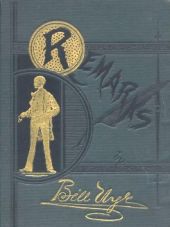Remarks
by Bill Nye

A long and exhaustive examination of the history of flying machines enables me to give briefly some of the main points of a few, for the benefit of those who may be interested in this science. I give what I do in order to prepare the public to take advantage of the different methods, and be ready at once to fly as soon as the weather gets pleasant.
A Frenchman invented a flying-machine, or dofunny, as we scientists would term it, in 1600 and something, whereby he could sail down from the woodshed and not break his neck. He could not rise from the ground like a lark and trill a few notes as he skimmed through the sky, but he could fall off an ordinary hay stack like a setting hen, with the aid of his wings. His name was Besnier.
One hundred and twenty-five years after that a prisoner at Vienna, named Jacob Dagen, told the jailer that he could fly. The jailer seemed incredulous, and so Jake constructed a pair of double barrel umbrellas, that worked by hand, and fluttered with his machine into the air fifty feet. He came down in a direct line, and in doing so ran one of the umbrellas through his thorax. I am glad it is not the custom now to wear an umbrella in the thorax.
In England, during the present century, several inventors produced flying machines, but in an evil hour agreed to rise on them themselves, and so they died from their injuries. Some came down on top of the machines, while others preceded their inventions by a few feet, but the result was the same. The invention of flying machines has always been handicapped, as it were, by this fact Men invent a flying machine and then try to ride it and show it off, and thus they are prevented by death from perfecting their rolling stock and securing their right of way.
In 1842, Mr. William Henderson got out a “two-propeller” machine, and tried to incorporate a company to utilize it for the purpose of carrying letters, running errands, driving home the cows, lighting the Northern Lights and skimming the cream off the Milky Way, but it didn’t seem to compete very successfully with other modes of travel, and so Mr. Henderson wrapped it up in an old tent and put it away in the hay-mow.
In 1853, Mr. J.H. Johnson patented a balloon and parachute dingus which worked on the principle of a duck’s foot in the mud. I use scientific terms because I am unable to express myself in the common language of the vulgar herd. This machine had a tail which, under great excitement, it would throw over the dash board as it bounded through the air.
Probably the biggest thing in its way under this head was the revival of flying under the presidency of the Duke of Argyle, the society being called the Aeronautical Society of Great Britain. This society made some valuable calculations and experiments in the interest of aerostation, adding much to our scientific knowledge, and filling London with cripples.
In 1869, Mr. Joseph T. Kaufman invented and turned loose upon the people of Glasgow an infernal machine intended to soar considerably in a quiet kind of way and to be propelled by steam. It looked like the bird known to ornithology as the flyupithecrick, and had an air brake, patent coupler, buffer and platform. It was intended to hold two men on ice and a rosewood casket with silver handles. It was mounted on wheels, and, as it did not seem to skim through the air very much, the people of Glasgow hitched a clothes line to it and used it for a band wagon.
Rufus Porter invented an aerial dewdad ten years ago in Connecticut, where so many crimes have been committed since Mark Twain moved there. This was called the “aeraport,” and looked like a seed wart floating through space. This engine was worked by springs connected with propellers. A saloon was suspended beneath it, I presume on the principle that when a man is intoxicated he weighs a pound less. This machine flew around the rotunda of the Merchants’ Exchange, in New York City, eleven times, like a hen with her head cut off, but has not been on the wing much since then.
Other flying machines have been invented, but the air is not peopled with them as I write. Most of them have folded their pinions and sought the seclusion of a hen-house. It is to be hoped that very soon some such machine will be perfected, whereby a man may flit from the fifth story window of the Grand Pacific Hotel, in Chicago, to Montreal before breakfast, leaving nothing in his room but the furniture and his kind regards.
Such an invention would be hailed with much joy, and the sale would be enormous. Now, however, the matter is still in its infancy. The mechanical birds invented for the purpose of skimming through the ether blue, have not skum. The machines were built with high hopes and a throbbing heart, but the aforesaid ether remains unskum as we go to press. The Milky Way is in the same condition, awaiting the arrival of the fearless skimmer. Will men ever be permitted to pierce the utmost details of the sky and ramble around among the stars with a gum overcoat on? Sometimes I trow he will, and then again I ween not.
 Continue...
Continue...![[Buy at Amazon]](http://images.amazon.com/images/P/B000875S1G.01.MZZZZZZZ.jpg)